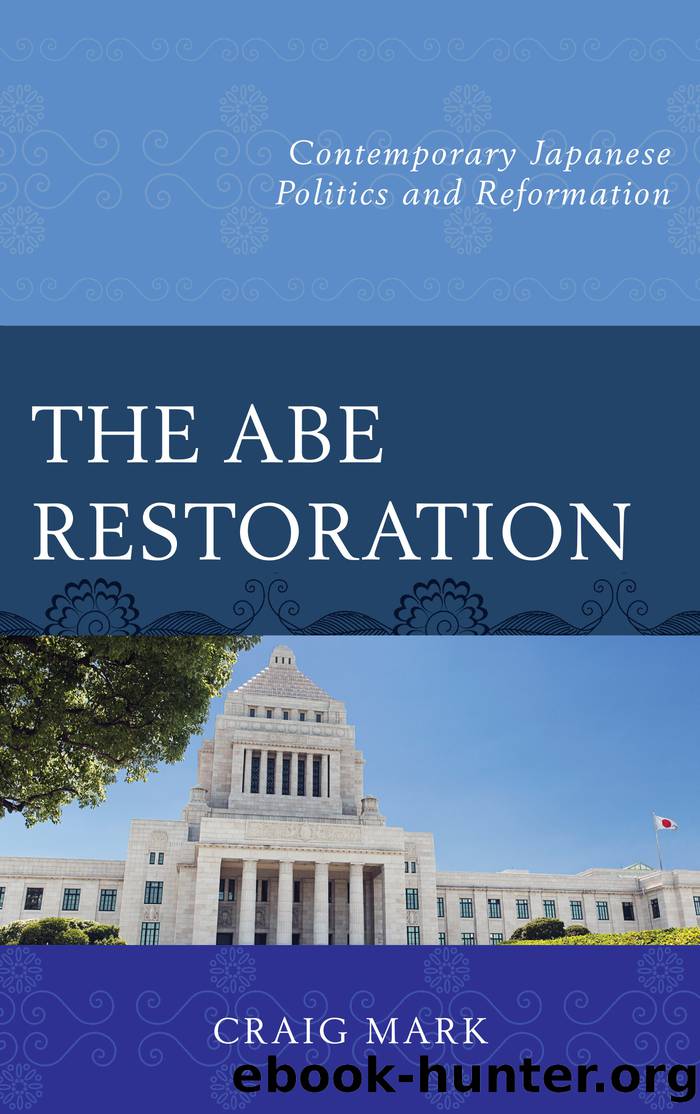The Abe Restoration by Mark Craig;

Author:Mark, Craig;
Language: eng
Format: epub
Tags: undefined
Publisher: Lexington Books
Published: 2012-08-15T00:00:00+00:00
Abe in the US
In preparation for Abeâs visit to the United States from April 28 to May 3, the new US secretary of defense, Ashton Carter, preceded this with a regional visit to Japan and South Korea on April 7â9. Carter amped up the importance of completing the TPP as vital to Asia-Pacific prosperity and security, calling it as âimportant as another aircraft carrier.â It supplements the US ârebalance,â or âPivotâ of its forces to the Pacific, comprising the redeployment of new long-range stealth bombers, cruise missiles, and space-based and Electronic Warfare (EW) capabilities. The USAFâs advanced aircraft, such as the F-22, F-35, B-2, and the US Navyâs Aegis and stealth destroyers will also be deployed, along with increased US Marine Corps detachments. Trilateral cooperation in maritime security, and defense technology sharing with Japan and Australia will also be central to this strategy. Carter expressed concern about Chinaâs âopaqueâ defense budget, its activities in the South China Sea, and its alleged role in cyber attacks, stating that China and the United States are ânot allies, but donât have to be adversaries.â[45]
At the start of his Japan visit, Carter warned against any militarization of territorial issues in the Pacific; as the United States and the Philippines conducted military exercises around the Spratly Islands, in the largest drills of such kind since 2000. This followed warnings by the US Commander of Pacific Command (CINPAC) to Congress over Chinaâs âGreat Wall of Sand,â its construction of islands on South China Sea reefs.[46] The United States is looking for increased Japanese patrols in East Asian waters, as Carterâs visit confirmed revision of the US-Japan defense cooperation guidelines, last altered in 1997. This will facilitate Abeâs constitutional reinterpretation allowing greater potential scope of action for the SDF to support US forces, potentially allowing the SDF to supply the United States and the Philippines in any future South China Sea clash with China. To this end, Abe emphasized the importance of the US-Japan alliance during Carterâs visit.[47]
Highlighting the possible danger that such clashes could result from an escalation of even low-level military incidents, the ASDF reported its intercept scrambles against Chinese and Russian reconnaissance incursions were at record levels last seen during the Cold War, with 943 in 2014, up 16 percent from the previous year.[48] On his way to the United States, Abe gave a speech at the Asian-African Summit in Indonesia, where he expressed âremorse,â for Japanâs role in the Second World War, but gave no additional apology. His second bilateral sideline meeting with Xi Jinping indicated the gradual improvement in bilateral relations was continuing.[49]
Abeâs trip to the United States was the first official visit by a Japanese prime minister in nine years, and his address to Congress was only the third by a Japanese prime minister. The relatively small state dinner held for Abe was only the eighth conducted by President Obama, the lowest number since Truman.[50] During his address to Congress, Abe declared a fundamental deepening of the alliance, as Japan supported the United States ârebalancingâ in the Pacific.
Download
This site does not store any files on its server. We only index and link to content provided by other sites. Please contact the content providers to delete copyright contents if any and email us, we'll remove relevant links or contents immediately.
| Central Asia | Southeast Asia |
| China | Hong Kong |
| India | Japan |
| Korea | Pakistan |
| Philippines | Russia |
The Rape of Nanking by Iris Chang(3518)
The Sympathizer by Viet Thanh Nguyen(3487)
World without end by Ken Follett(3008)
Ants Among Elephants by Sujatha Gidla(2925)
Blood and Sand by Alex Von Tunzelmann(2610)
Japanese Design by Patricia J. Graham(2557)
City of Djinns: a year in Delhi by William Dalrymple(2137)
Inglorious Empire by Shashi Tharoor(2102)
Foreign Devils on the Silk Road: The Search for the Lost Treasures of Central Asia by Peter Hopkirk(2056)
In Order to Live: A North Korean Girl's Journey to Freedom by Yeonmi Park(2055)
Tokyo by Rob Goss(2018)
India's Ancient Past by R.S. Sharma(1988)
India's biggest cover-up by Dhar Anuj(1985)
The Great Game: On Secret Service in High Asia by Peter Hopkirk(1962)
Tokyo Geek's Guide: Manga, Anime, Gaming, Cosplay, Toys, Idols & More - The Ultimate Guide to Japan's Otaku Culture by Simone Gianni(1947)
Goodbye Madame Butterfly(1937)
The Queen of Nothing by Holly Black(1757)
Living Silence in Burma by Christina Fink(1731)
Batik by Rudolf Smend(1722)
